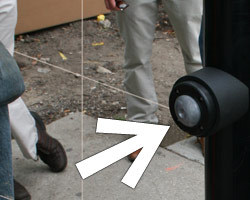Among its many provisions, the Americans with Disabilities Act of 1990 was intended to ensure equal access to public transportation for people with disabilities. The CTA is currently in compliance with these regulations and continues to seek out ways to incorporate new or upgrade existing accessibility features as part of ongoing capital improvement work.
The following is an overview of the accessible services and features currently available to people with disabilities traveling the CTA bus and rail system.
See also:
On this page
Bus vehicle features
Since 2005, our entire bus fleet has been accessible to people with disabilities and today's models are designed around it, including low-floor designs and ramps that flip outward (rather than steps and complex lift mechanisms that took longer to deploy and were more difficult to maintain).
Although bus models in our fleet may vary, they're all equipped with the following accessible features:
- Ramps at the forward doors
- Designated priority seating and wheelchair securement areas
- Automated voice announcements inside and outside of the vehicle, accompanying text displayed on dynamic LED displays for route and stop information.
Bus shelter features
Hundreds of bus shelters are equipped with estimated arrival information in the form of an outward-facing LED sign on one side of the shelter for approaching riders to see when the next buses arrive, along with reroute and bus stop relocation information.

Each bus shelter sign is equipped with a push button and speaker to announce the estimated arrival times for our riders with visual impairments. The push button is located inside the shelter, typically on the left front pole when facing the street, at a height of 42 inches above the ground—it also chirps occasionally letting riders who are blind or who have limited vision know that the shelter is equipped with arrival information.
Push the button once and a speaker inside the shelter will announce upcoming arrivals. If the audio says "Push again for alerts" at the end of a sequence of arrivals, push the button one more time to hear customer alerts about reroutes that might cause your stop to not be served, reroutes ahead on routes that serve that stop and reroutes along other parts of the route in case it affects your trip.
Loop Link shelters have similar features, including a button toward the front of the stop that announces arrivals shown on screens in the station.
Railcar features
All CTA rail cars are accessible to people with disabilities. Roughly 50% of our current fleet consists of the new 5000-series rail cars, which offer several new features to help meet the needs of riders with disabilities. Our oldest rail cars, which already have a number of accessibility features eventually will be replaced by the 7000-series which will be designed to meet the latest ADA regulations and are expected to begin arriving as early as 2020.
The following are some of the accessibility features currently available across our rail fleet:
- Accessible doors
- Priority seats and designated wheelchair securement areas, as well as emergency call buttons available within this area
- Exterior and interior automated voice announcements for stops and routes
- Braille signage
- Two interior LED signs displaying automated announcement text (5000-series only)
Rail Station Features
Currently, 103 of our 145 rail stations are accessible.
In general, during rail service hours, personal support from CTA personnel is available at every rail station. Customer assistance buttons are located in the stationhouse and along the platform and can be used to request assistance. Other accessibility features at rail stations include:
- Audio and Braille equipped fare vending machines (Learn more: Physical Description of Vending Machines)
- Wheelchair accessible fare gates
- Braille station and platform signage
- Elevators and/or ramps
- Tactile platform edging
- Gap filler boards to bridge the space between the platform and the rail car
New and improved faregates are being installed at rail stations across the system that are taller, more durable than existing special Access Gates, and are also compliant with the Americans with Disabilities Act (ADA).
The updated ADA faregates include an improved locking mechanism with more reliable hardware, but will still operate in the same manner as the existing gates. The new faregates will enhance accessible entrances at our rail stations including those entrances that may not be staffed with a Customer Assistant. Since the new doors are taller, the exit button will be more difficult to reach from the unpaid side, which will help reduce fare evasion. The installation of all the faregates are expected to be complete by early 2024.
Travel Tools
To help make taking public transit even more convenient, CTA travel tools are available allowing customers to make informed decisions before and during their trip:
- Receive alerts about reroutes, stop relocations, planned work affecting service and the status of elevators anywhere on the 'L' system through free subscription text/email service at CTA Updates
- More than 400 bus shelters equipped with CTA Bus Tracker digital displays and audio buttons throughout the service region
- Estimated train arrival times accessible online, via text or through the Ventra app
Reduced and Ride Free Program Fare Cards
For qualified riders with disabilities, the Regional Transportation Authority (RTA) offers a Reduced Fare Permit, which offers CTA fares and transfers at a discounted rate. To learn more or apply, call RTA at 312-913-3110 (voice) or 312-836-4949 (TTY).
Rides are free on CTA buses and trains for any Illinois resident with a disability and enrolled in the Benefit Access Program. Information about this program is available by calling the Department on Aging at 1-800-252-8966 (voice) or 1-888-206-1327 (TTY) or by visiting www.illinois.gov/aging.
Learn more about Reduced Fare and Free Ride Programs.